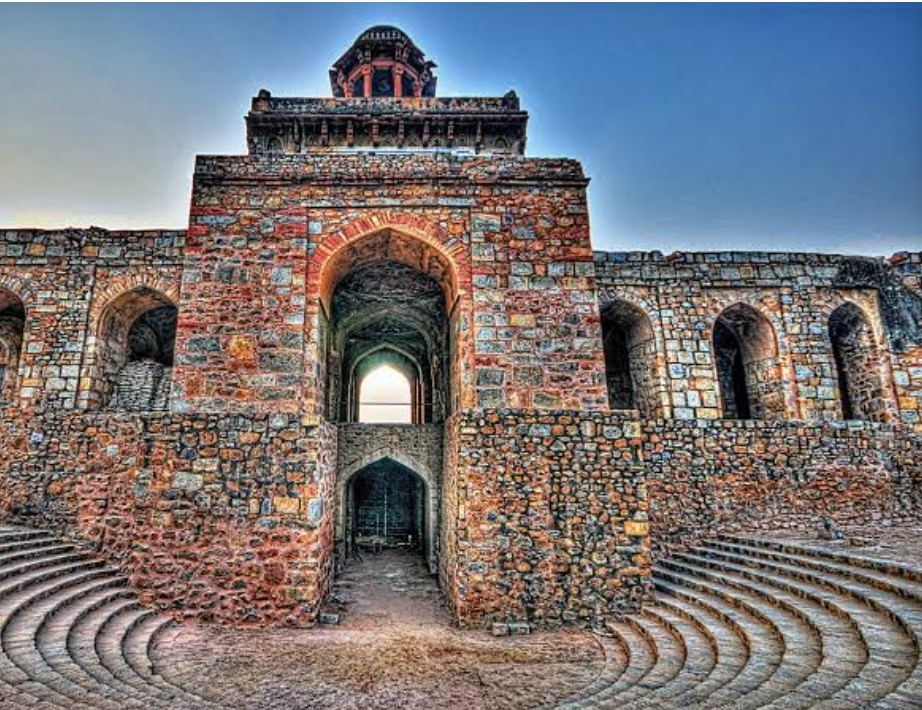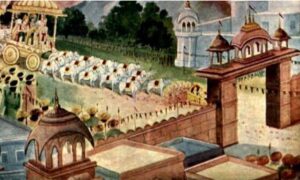Indraprastha City Of Virtue: Tracing The Footsteps of Pandavas and Krishna
Founding of Indraprastha:
Khandavprastha was a dense and ancient forest inhabited by a serpent named Takshaka and a divine bird named Garuda. Indra, the king of the gods, had gifted this forest to Takshaka, and Garuda served as his protector.When the Pandavas were granted the kingdom of Khandavprastha by Lord Krishna, they needed to clear the forest to establish their capital, Indraprastha.
Krishna advised them to seek the help of Agni, the fire god, to burn down the forest.Agni agreed to consume the forest and asked for Arjuna and Krishna’s assistance. With the help of Agni, Arjuna and Krishna burned down the entire Khandavprastha forest. Takshaka, the serpent, managed to escape, and Indra’s divine elephant, Airavata, was saved by Arjuna.In return for their help, Agni gifted Arjuna a divine bow called Gandiva and a chariot.
Agni also blessed Krishna, acknowledging his divine nature.After the forest was burned down, the Pandavas built their magnificent capital city, Indraprastha, on the ashes of the Khandavprastha forest. Indraprastha became a symbol of the Pandavas’ might and glory.
Construction of the Palace of Illusions (Maya Sabha):
Mayasura, also known as Maya Danava, was a divine architect, engineer, and craftsman in Hindu mythology. He was a master builder renowned for his exceptional skills in construction and illusionary architecture. According to the Mahabharata, Mayasura played a significant role in the creation of Indraprastha, the legendary capital city of the Pandavas.
When the Pandavas received the Khandavprastha region (later known as Indraprastha) from Lord Krishna, they sought the assistance of Mayasura to build their capital city. Mayasura used his unparalleled architectural talents to design and construct the magnificent city of Indraprastha. Under his supervision, the city was adorned with opulent palaces, grand halls, and beautiful gardens, making it a symbol of splendor and architectural marvel.
Key Features of Indraprastha:
1. Magnificent Palaces: Indraprastha was adorned with magnificent palaces that showcased architectural brilliance and grandeur. The most famous of these was the Palace of Illusions (Maya Sabha), which was constructed by the architect Maya and was known for its magical and illusionary qualities.
2. Beautiful Gardens: The city was surrounded by lush gardens and scenic landscapes. Gardens and parks were an essential part of the city’s layout, providing natural beauty and tranquility.
3. Opulent Temples: Indraprastha likely had temples dedicated to various deities. The presence of sacred temples was common in ancient cities, and they served as centers of religious and cultural activities.
4. Marketplaces: The city would have bustling marketplaces where traders and merchants from different regions gathered to exchange goods. Marketplaces were hubs of economic activities and cultural exchanges.
5. Residential Areas: Indraprastha would have had well-planned residential areas for its citizens, including homes of nobles, ministers, and common people. The city’s layout would likely have been organized to accommodate different sections of society.
6. Defensive Structures: Given the political context of the Mahabharata, it is plausible that Indraprastha had defensive structures such as walls and fortifications to protect its residents from external threats.
Game of Dice and Exile:
Duryodhana, the eldest Kaurava, invited the Pandavas to a game of dice in the Maya Sabha. With deceit and manipulation, Duryodhana tricked Yudhishthira, the eldest Pandava, into staking his kingdom, wealth, brothers, and even himself in the game. The Pandavas lost the game and were sent into exile for twelve years, including one year in complete anonymity.
Return and Kurukshetra War:
After completing their exile, the Pandavas returned to reclaim their kingdom. The refusal of the Kauravas to return their land and the subsequent peace negotiations failed, leading to the great Kurukshetra War. The war was fought between the Pandavas and the Kauravas, resulting in the victory of the Pandavas and the restoration of Indraprastha to its rightful rulers.
Present day Location:
In present-day Delhi, there are several historical and archaeological sites that are believed to be associated with the ancient city of Indraprastha. One such site is Purana Qila (Old Fort), which is considered by some scholars and historians to be the location of the legendary city. Purana Qila is one of the oldest forts in Delhi and has archaeological excavations dating back to ancient times.
The story of Indraprastha illustrates themes of deceit, betrayal, and the consequences of unrighteous actions. It also emphasizes the importance of dharma (righteousness) and the ultimate triumph of truth and justice. Indraprastha remains a significant part of the Mahabharata narrative, symbolizing both the glory and challenges faced by the Pandavas in their epic journey.




1 thought on “Indraprastha City Of Virtue: Tracing The Footsteps of Pandavas and Krishna”